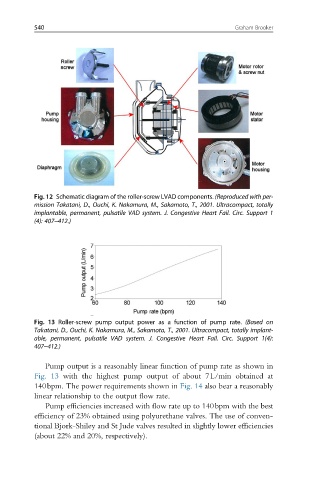Page 546 - Handbook of Biomechatronics
P. 546
540 Graham Brooker
Fig. 12 Schematic diagram of the roller-screw LVAD components. (Reproduced with per-
mission Takatani, D., Ouchi, K. Nakamura, M., Sakamoto, T., 2001. Ultracompact, totally
implantable, permanent, pulsatile VAD system. J. Congestive Heart Fail. Circ. Support 1
(4): 407–412.)
Fig. 13 Roller-screw pump output power as a function of pump rate. (Based on
Takatani, D., Ouchi, K. Nakamura, M., Sakamoto, T., 2001. Ultracompact, totally implant-
able, permanent, pulsatile VAD system. J. Congestive Heart Fail. Circ. Support 1(4):
407–412.)
Pump output is a reasonably linear function of pump rate as shown in
Fig. 13 with the highest pump output of about 7L/min obtained at
140bpm. The power requirements shown in Fig. 14 also bear a reasonably
linear relationship to the output flow rate.
Pump efficiencies increased with flow rate up to 140bpm with the best
efficiency of 23% obtained using polyurethane valves. The use of conven-
tional Bjork-Shiley and St Jude valves resulted in slightly lower efficiencies
(about 22% and 20%, respectively).

